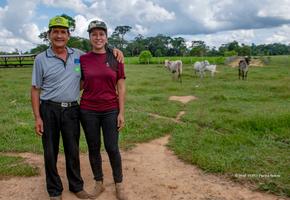As part of our work on food, we've been supporting states in Peru to develop more sustainable supply chains. As well as cutting emissions, this helps communities adapt to a changing - and sometimes unpredictable - climate.
This work has now influenced policy development at the national level, with the Peruvian government recognising that not only are there strong climate reasons for sustainable livestock farming but local interest and a market as well.

By unpicking issues around market access, financing, quality management and the best models of productivity and production, we've been helping to demonstrate the value states and regions can add to national and international climate change debates.
Sustainable cattle ranching
Through the Under2 Coalition, Climate Group has been working on sustainable cattle ranching in Latin America since we launched a pilot project in Madre de Dios, Peru, in 2021 with WWF and the Tropical Forest Alliance – supported by the UK Government.
Through this work, we’ve established cattle farmer field schools (FFS) and promoted regenerative animal husbandry in one of the most vulnerable parts of the world. This is essential because climate change and nature depletion are deeply intertwined. They are part of the same system-wide crisis and we can’t address one without also addressing the other.
Farming has widespread environmental impacts
As a sector, farming is one of the biggest contributors to both climate change and biodiversity loss. Intensive farming can change how land is used, degrade soils and damage habitats so that they are uninhabitable to many species.

Cattle farming in the Amazon region has been highlighted many times for its contribution to deforestation and carbon emissions. The situation has become so precarious that scientists suggest we may reach a tipping point for the health of the rainforest in a matter of years.
Since 2021 we’ve seen our project in Madre de Dios extended into other Amazonian regions such as replicating FFS in Oxapampa and developing a public investment plan for sustainable livestock in Huánuco. We’ve also joined the Alliance for Regenerative Ranching in the Peruvian Amazon (AGRAP). This powerful initiative is part of the Coalition for Sustainable Production – a collaboration driving action, steering dialogue and encouraging commitments for deforestation-free supply chains in Peru.
48% of all greenhouse gas emissions in Peru come from deforestation, which in turn is mainly driven by agricultural activities (MINAM, 2023). Regenerative farming reduces this footprint through the planting of native plants and the reduction of cattle number per hectare of land. This also improves the quality of the beef farmers produce because the cows’ diets are more varied and natural.
Community involvement can build bridges to policy development
During recent phases of our project, we and our project partners have been working closely with 6 Amazonian regional states and the Amazon community council – the council representing all seven Peruvian Amazonian states. We talked to them about issues like market access, public and private financing, quality management of beef and the best models of productivity and production for more sustainable farming. We have also been working to make the beef supply chain more sustainable through engagement with businesses in the sector.

All of this proved to be a practical demonstration to Peru’s national government that not only are there strong climate reasons for sustainable livestock farming but local interest and a market as well. Along with potential future funders, officials from the Ministry of Agriculture visited field farming schools in Madre de Dios to hear more about how they are run and the results they are yielding.
New policies around sustainable livestock production
Most exciting of all, the national government has now issued a declaration in support of this work. Ministerial Resolution No. 0077-2024-Midagr highlights that sustainable livestock production is of national interest to avoid inappropriate use of natural resources and to cut deforestation. The General Directorate of Livestock Development (DGDG) has also been asked to formulate, coordinate, monitor and supervise projects to promote sustainable livestock farming and to implement best practice within the sector.

Recognising the importance of farming in a country where 25% of the economically active population is employed in the agricultural sector, Marco Enciso, former Head of the General Directorate of Livestock Development (DGDG) of the Ministry of Agriculture said that the sector’s productivity and profitability was being severely hindered by environmental impacts. He also stressed that "sustainable livestock farming not only ensures the supply of high-quality food for the world's population, but…plays a critical role in preserving the environment and promoting animal welfare.”
From subnational to national
The expansion of regenerative ranching principles from local to national level is a perfect example of the value states and regions add to the climate change debate. It is often these subnational governments that act as a testing zone for policies that work and then advocate these policies across other government bodies. Once the benefits of more sustainable farming had been seen in practice – for nature, for animals and for people – it was easier to argue for these practices to become more widespread.
We’re delighted that the Peruvian Government has taken such a positive stance on farming in its Amazonian regions and we hope, through the continuing work of the Under2 Coalition and our partners, to keep building on this strong foundation. We have to solve the climate and biodiversity crises and time is of the essence. Thanks to the efforts of our states in Peru, we have now taken a big step in the right direction.

